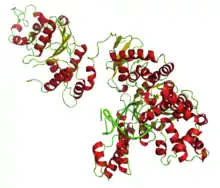ADN polymérases thermostables
Les ADN polymérases thermostables sont des ADN polymérases issues d'organismes thermophiles, comme certaines bactéries de l'ordre des Archaea et leurs pathogènes. Ces polymérases sont stables à hautes températures (env. 100°C) et peuvent donc être utilisées pour la réaction en chaîne par polymérase (angl. PCR) et autres méthodes permettant l'amplification et la modification de l'ADN.

Polymérases bactériennes
Les principales polymérases thermostables issues de bactéries sont la Taq polymérase, la Tfl polymérase, la Tma polymérase, la Tne polymérase et la Tth polymérase [1] - [2] - [3].
Ces polymérases bactériennes sont de type A. Elles ont une activité polymérase 5'→3', une activité exonucléase 5'→3' et ajoutent une adénosine à l'extrémité 3' de l'ADN synthétisé (angl. sticky ends). La processivité (angl. processivity) est une propriété des ADN polymérases définie comme le nombre moyen de paires de bases incorporées par la polymérase avant de se détacher de l'ADN servant de matrice (angl. template). Une processivité trop petite limite donc la distance maximale entre les amorces utilisées dans une réaction de qPCR. La processivité de la Taq polymérase est à peu près de 200 paires de bases.
Polymérases d'archées

Les ADN polymérases thermostables d'Archaea les plus utilisées sont la Pfu polymérase[1], la Pwo polymérase, la KOD polymérase[4], la Tli polymérase (synonyme Vent)[5], la Tag polymérase[6], la Tce polymérase[7], la Tgo polymérase[8], la TNA1 polymérase[9], la Tpe polymérase[10], la Tthi polymérase[11], la Neq polymérase[12] et la Pab polymérase[13].
Notes et références
- J. Cline, J. C. Braman, H. H. Hogrefe: PCR fidelity of pfu DNA polymerase and other thermostable DNA polymerases. In: Nucleic Acids Res., Bd. 24, Nr. 18, 1996, S. 3546–3551. ; PMC 146123.
- B. Villbrandt, H. Sobek, B. Frey, D. Schomburg: Domain exchange: chimeras of Thermus aquaticus DNA polymerase, Escherichia coli DNA polymerase I and Thermotoga neapolitana DNA polymerase. In: Protein Eng., Bd. 13, Nr. 9, 2000, S. 645–654. .
- W. Abu Al-Soud, P. Râdström: Capacity of nine thermostable DNA polymerases to mediate DNA amplification in the presence of PCR-inhibiting samples. In: Appl. Environ. Microbiol., Bd. 64, Nr. 10, 1998, S. 3748–3753. ; PMC 106538.
- M. Takagi, M. Nishioka, H. Kakihara, M. Kitabayashi, H. Inoue, B. Kawakami, M. Oka, T. Imanaka: Characterization of DNA polymerase from Pyrococcus sp. strain KOD1 and its application to PCR. In: Appl. Environ. Microbiol., Bd. 63, Nr. 11, 1997, S. 4504–4510. ; PMC 168769.
- H. Kong, R. B. Kucera, W. E. Jack: Characterization of a DNA polymerase from the hyperthermophile archaea Thermococcus litoralis. Vent DNA polymerase, steady state kinetics, thermal stability, processivity, strand displacement, and exonuclease activities. In: J Biol Chem., Bd. 268, Nr. 3, 1993, S. 1965–1975. .
- K. Böhlke, F. M. Pisani, C. E. Vorgias, B. Frey, H. Sobek, M. Rossi, G. Antranikian: PCR performance of the B-type DNA polymerase from the thermophilic euryarchaeon Thermococcus aggregans improved by mutations in the Y-GG/A motif. In: Nucleic Acids Res., Bd. 28, Nr. 20, 2000, S. 3910–3917. ; PMC 110800.
- K. P. Kim, H. Bae, I. H. Kim, S. T. Kwon: Cloning, expression, and PCR application of DNA polymerase from the hyperthermophilic archaeon, Thermococcus celer. In: Biotechnol Lett. (2011), Bd. 33(2), S. 339-46. .
- B. Arezi, W. Xing, J. A. Sorge, H. H. Hogrefe: Amplification efficiency of thermostable DNA polymerases. In: Analytical biochemistry. Band 321, Nummer 2, Oktober 2003, S. 226–235, . PDF.
- Y. Cho, H. S. Lee, Y. J. Kim, S. G. Kang, S. J. Kim, J. H. Lee: Characterization of a dUTPase from the hyperthermophilic archaeon Thermococcus onnurineus NA1 and its application in polymerase chain reaction amplification. In: Mar Biotechnol (NY), Bd. 9, Nr. 4, 2007, S. 450–458. .
- J. I. Lee, Y. J. Kim, H. Bae, S. S. Cho, J. H. Lee, S. T. Kwon: Biochemical properties and PCR performance of a family B DNA polymerase from hyperthermophilic euryarchaeon Thermococcus peptonophilus. In: Appl Biochem Biotechnol., Bd. 160, Nr. 6, 2010, S. 1585–1899. .
- D. Marsic, J. M. Flaman, J. D. Ng: New DNA polymerase from the hyperthermophilic marine archaeon Thermococcus thioreducens. In: Extremophiles, Bd. 12, Nr. 6, 2008, S. 775–788. .
- J. G. Song, E. J. Kil, S. S. Cho, I. H. Kim, S. T. Kwon: An amino acid residue in the middle of the fingers subdomain is involved in Neq DNA polymerase processivity: enhanced processivity of engineered Neq DNA polymerase and its PCR application. In: Protein Eng. Des. Sel., Bd. 23, Nr. 11, 2010, S. 835–842. .
- J. Dietrich, P. Schmitt, M. Zieger, B. Preve, J. L. Rolland, H. Chaabihi, Y. Gueguen: PCR performance of the highly thermostable proof-reading B-type DNA polymerase from Pyrococcus abyssi. In: FEMS Microbiol Lett., Bd. 217, Nr. 1, 2002, S. 89–94. .